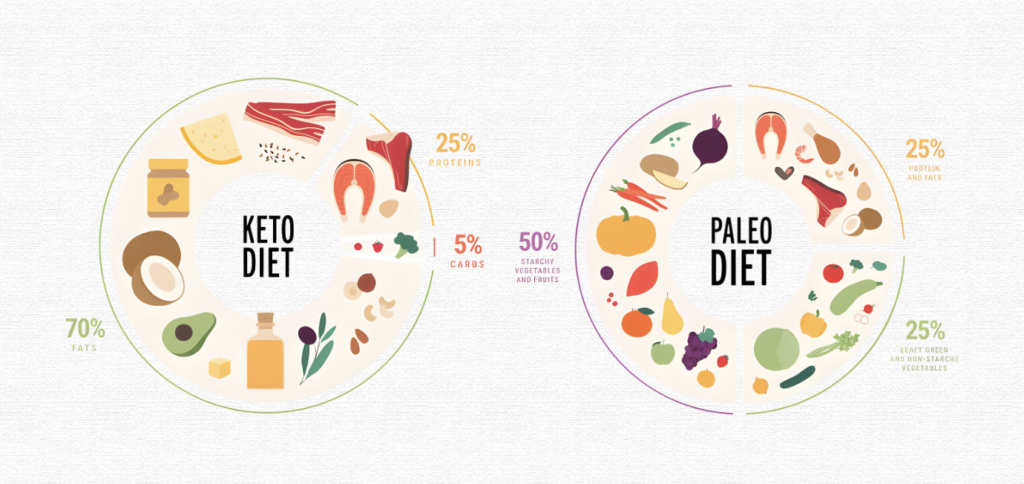Kinds of Diets
Paleo Diet vs Keto Diet – Which Works Best?
Do you want to enhance your health and reduce weight but aren’t sure which diet is best for you? The Paleo diet and keto diet are two popular choices that have received a lot of attention in recent years. Both diets have advantages, but what are the main differences? In this article, we will compare the Paleo diet and Keto diet to help you make an informed decision.
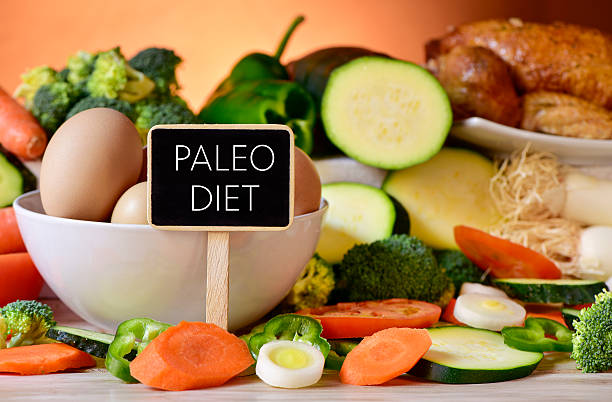
Understanding the Paleo Diet
The Paleo diet, sometimes known as the “caveman” diet, emphasizes eating like our predecessors did during the Paleolithic period. It focuses on whole, unprocessed foods such lean meats, fruits, vegetables, nuts, and seeds. The Paleo diet’s primary idea is to exclude processed foods, grains, legumes, and dairy products, which were not part of our ancestors’ diets.
One of the main reasons individuals select the Paleo diet is that it emphasizes complete, nutrient-dense foods. The Paleo diet seeks to give critical nutrients to the body while also promoting a healthy lifestyle by eliminating processed foods and focusing on natural, unprocessed products. Individuals who follow the Paleo diet may also lose weight, improve their digestion, have more energy, and have less inflammation.
However, it’s crucial to recognize that the Paleo diet has significant restrictions. For example, it restricts the consumption of grains and legumes, which are high in fiber, vitamins, and minerals. Furthermore, for people who rely primarily on dairy products for calcium and other critical elements, the Paleo diet may be ineffective unless they can locate other sources.
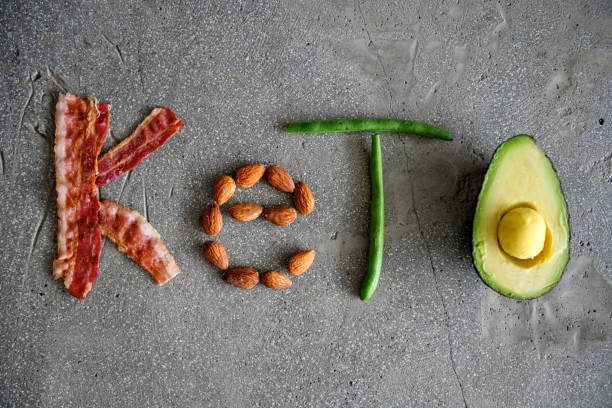
Understanding the Keto Diet
However, the Keto diet is a low-carb, high-fat diet that aims to induce ketosis, a state in which your body burns fat instead of carbohydrates. The Keto diet emphasizes healthy fats, moderate protein, and few carbohydrates. By substantially cutting carbs, the body enters ketosis, a fat-burning metabolic state.
The keto diet emphasizes ketosis. Eating avocados, nuts, seeds, and fatty fish and fewer carbohydrates, especially processed sugars and grains, achieves this. Keto dieters must watch their macronutrient consumption to establish a balanced diet of fats, proteins, and carbohydrates.
Due to its weight loss potential, the Keto diet is popular. Ketosis improves fat burning for energy, which may lead to considerable weight loss. The Keto diet also improves insulin sensitivity, reduces inflammation, and may treat epilepsy and type 2 diabetes.
However, the Keto diet requires strict macronutrient ratios and may be difficult to maintain. The “Keto flu,” or early transition period, can cause fatigue, headaches, and nausea as the body adjusts to burning fat instead of carbohydrates.
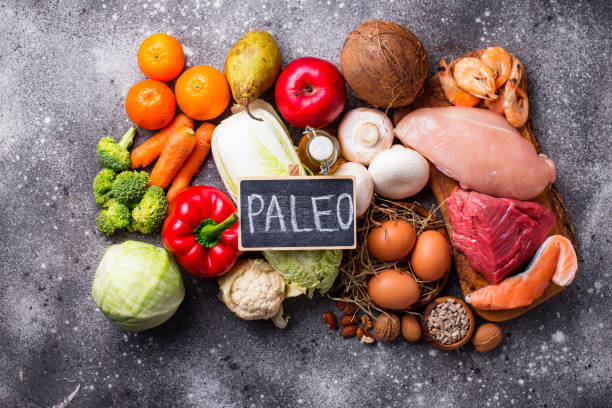
Health Benefits of the Paleo Diet
The Paleo diet has various possible health benefits. The Paleo diet, which emphasizes complete, unprocessed foods, provides the body with critical nutrients, vitamins, and minerals. This can lead to better digestion, more energy, and less inflammation. Furthermore, the Paleo diet may help people lose weight by lowering calorie consumption and improving satiety.
One of the Paleo diet’s primary advantages is its emphasis on high-quality protein sources. Lean meats, including chicken, turkey, and grass-fed cattle, are high in necessary amino acids, which are the building blocks of proteins. Individuals following the Paleo diet can assist muscle growth, repair, and maintenance by having a sufficient protein intake.
The Paleo diet also encourages the consumption of fruits and vegetables, which are high in fiber, antioxidants, and other necessary elements. These plant-based foods can boost intestinal health, lower the risk of chronic disease, and improve general well-being.
While the Paleo diet has numerous health benefits, it should be noted that it may not be appropriate for everyone. Individuals with specific medical issues, such as kidney disease or diabetes, should speak with a doctor before beginning the Paleo diet. Furthermore, the diet’s stringent character may make it difficult for certain people to stick to it over time.
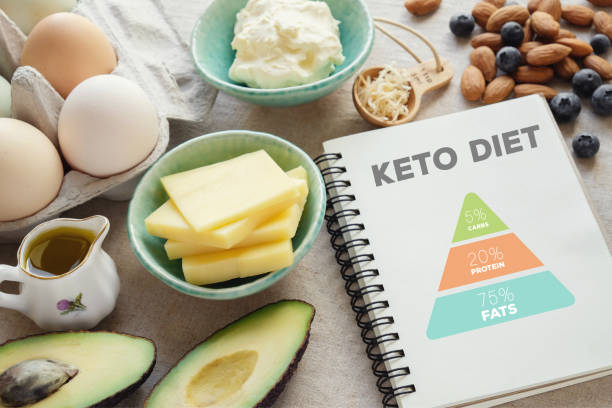
Health Benefits of the Keto Diet
The Keto diet has a number of potential health benefits, most notably its capacity to induce and maintain ketosis. When the body is in ketosis, it becomes more efficient at burning fat for energy, resulting in dramatic weight reduction. This is especially useful for people who are overweight or obese and want to enhance their general health.
In addition to weight loss, studies have indicated that the Keto diet improves insulin sensitivity and blood sugar control. Reducing carbohydrate intake reduces the body’s insulin response, which can benefit people with type 2 diabetes or insulin resistance. Furthermore, the Keto diet has been investigated for its possible therapeutic effects in treating epilepsy, particularly in youngsters.
Another potential health advantage of the Keto diet is its effect on cognitive function. The brain demands a steady supply of energy, and when in ketosis, it can effectively use ketones as an alternate fuel source. This has prompted study on the efficacy of the Keto diet in boosting cognitive function and lowering the risk of neurodegenerative disorders like Alzheimer’s.
While the Keto diet offers some potential health benefits, it’s vital to proceed with caution. The diet necessitates strict adherence to certain macronutrient ratios and may be difficult to follow, particularly for those accustomed to a greater carbohydrate intake. Furthermore, the Keto diet’s long-term effects are still being investigated, and more research is required to properly grasp its potential benefits and hazards.
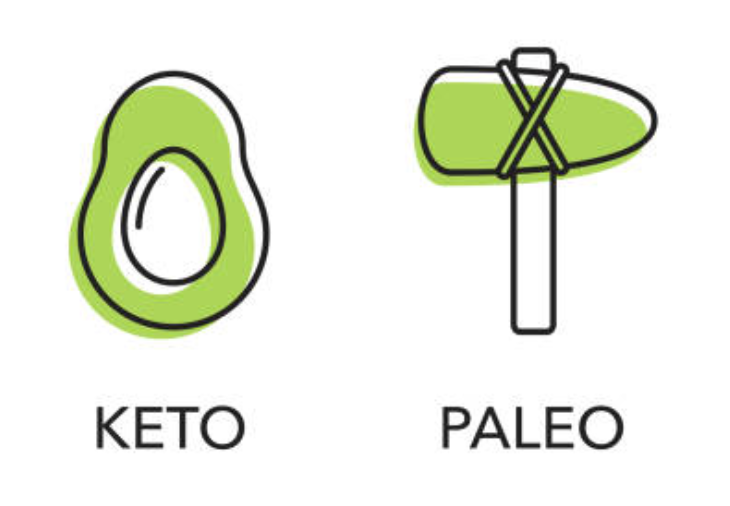
Key Differences Between the Paleo Diet and the Keto Diet
While the Paleo diet and the Keto diet have similarities, there are significant differences that distinguish them. The Paleo diet emphasizes eating entire, unadulterated foods while avoiding grains, legumes, and dairy products. The Keto diet, on the other hand, reduces carbohydrate intake in favor of a high-fat, moderate-protein diet in order to induce and maintain ketosis.
One of the most notable distinctions between the two diets is their macronutrient content. The Paleo diet does not impose exact macronutrient ratios, but instead stresses the quality of food choices. It promotes a balanced intake of protein, healthy fats, and carbohydrates from fruits and vegetables. On the contrary, the Keto diet advises people to consume a lot of healthy fats, moderate amounts of protein, and very few carbohydrates.
Another notable difference is the emphasis on ketosis. While the Paleo diet does not seek to induce ketosis, the Keto diet does in order to achieve weight loss and health advantages. To stay in ketosis, you must strictly stick to macronutrient ratios and check your carbohydrate consumption at all times.
Furthermore, the Paleo diet promotes the eating of entire, nutrient-dense foods such fruits, vegetables, lean meats, nuts, and seeds. It advocates a balanced approach to eating and encourages people to avoid processed foods and artificial ingredients. In contrast, the Keto diet does not value food quality as long as macronutrient ratios are met. This means that people following the Keto diet can eat processed meats, cheese, and other high-fat, low-carb items.

Which Diet is Better for Weight Loss?
Both the Paleo diet and Keto diet are touted for weight loss. Diets vary in effectiveness depending on taste, lifestyle, and metabolism.
Paleo emphasizes whole, unprocessed meals and avoids processed foods, wheat, and dairy to help you lose weight. Limiting calories and eating nutrient-dense foods helps people lose weight. However, the Paleo diet’s focus on whole foods and lax macronutrient ratios may make ketosis harder to achieve.
However, the Keto diet is designed to induce and maintain ketosis, which can lead to significant weight loss. Reduced carbohydrate intake and increased fat intake force the body to use fat for fuel. This can accelerate weight reduction, especially early in the program. However, the strict macronutrient ratios and adverse effects, such as the “Keto flu,” may make the Keto diet difficult to sustain.
Personal preferences, metabolic factors, and adherence define the best weight reduction diet. Choose a diet that fits your lifestyle and lasts.
Which Diet is Better for Overall Health?
Both Paleo diet and Keto diet improve health. The best diet for general health depends on personal needs, goals, and medical issues.
The Paleo diet emphasizes whole, unprocessed foods that provide nutrition, vitamins, and minerals. Avoiding processed foods and eating natural, unprocessed nutrients may improve digestion, energy, and inflammation. The Paleo diet encourages fruits, vegetables, and lean proteins, which can boost health.
However, the Keto diet may improve insulin sensitivity, reduce inflammation, and treat epilepsy and type 2 diabetes. The Keto diet, which cuts carbs and increases fat, can help you lose weight and improve your metabolism. Keto has also been studied for brain health and cognitive performance.
Remember that both diets have restrictions and may not suit everyone. Paleo restricts grains and legumes, which are strong in fiber, vitamins, and minerals. The Keto diet also requires strict macronutrient ratios, which may be challenging to maintain.
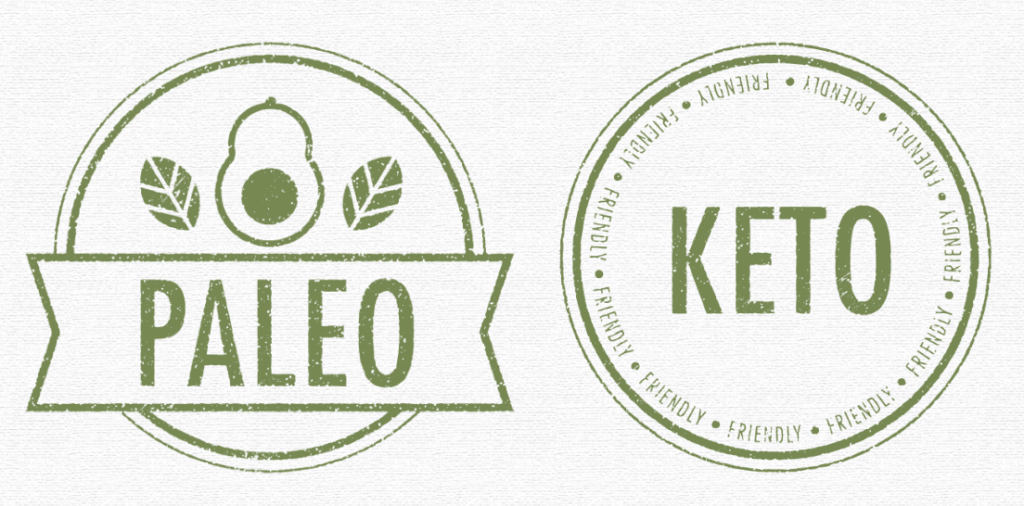
Paleo vs. Keto: Which Diet is Right for You?
The choice between the Paleo diet and the Keto diet is ultimately determined by your personal goals, tastes, and health concerns. Consider the following variables when selecting which diet is best for you:
- Weight Loss Goals: If your primary goal is weight loss and you are willing to strictly adhere to macronutrient ratios, the Keto diet may be a suitable option. However, if you prefer a more balanced approach to nutrition and want to focus on whole, unprocessed foods, the Paleo diet may be a better fit.
- Health Conditions: If you have specific health conditions, such as type 2 diabetes or epilepsy, the Keto diet may offer potential therapeutic benefits. However, if you have kidney disease or other medical conditions that require careful monitoring of protein intake, the Paleo diet may be a safer option.
- Sustainability: Consider your ability to sustain each diet in the long run. The Paleo diet offers more flexibility and a wider variety of food choices, which may make it easier to maintain. On the other hand, the strict macronutrient ratios and potential side effects of the Keto diet may make it more challenging to sustain.
- Food Preferences: Consider your personal food preferences and the types of foods you enjoy. The Paleo diet focuses on whole, unprocessed foods and eliminates grains, legumes, and dairy products. If you enjoy a wide variety of fruits, vegetables, and lean meats, the Paleo diet may be a good fit. Conversely, if you enjoy high-fat foods and are willing to restrict carbohydrate intake, the Keto diet may be more appealing.
Ultimately, the best diet for you is the one that aligns with your goals, preferences, and health conditions. It’s always a good idea to consult with a healthcare professional or a registered dietitian before making any significant dietary changes.
Conclusion
In conclusion, both the Paleo diet and Keto diet have advantages and possible health benefits. The Paleo diet emphasizes natural, unadulterated foods while recommending the avoidance of processed foods, grains, and dairy products. It can supply vital nutrients, aid in weight loss, and improve overall health and well-being. The Keto diet, on the other hand, is a high-fat, low-carbohydrate diet designed to induce and maintain ketosis. It can cause significant weight loss, enhance insulin sensitivity, and perhaps treat some medical disorders.
When deciding between the Paleo diet and the Keto diet, take into account your personal goals, tastes, and health. It is critical to select a diet that is sustainable, compatible with your lifestyle, and contains the nutrients required for maximum health. Remember to seek tailored counsel from a healthcare practitioner or a qualified dietician.
You may improve your health and well-being by making an informed decision and following a diet that is tailored to your specific needs. Whether you follow the Paleo or Keto diets, prioritize complete, unadulterated meals and pay attention to your body’s needs.
Trusted Health, Wellness, and Medical advice for your well-being

